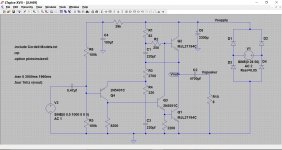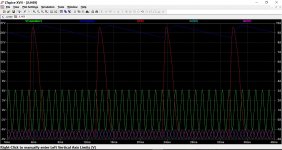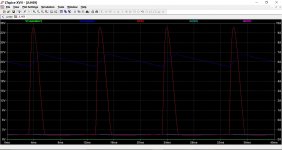Newbie question:
My understanding is that a large capacitor reservoir is useful for smoothing but in large part desired to hold up the rail voltage during times of high load.
I also understand that for some reason (that I don't have the background to understand), it is arguable that Class A amplifiers offers less ripple rejection than other classes. Lastly, Class A amps have a much more constant load than AB etc.
For these reasons does it make sense to seek more optimized filtering to smooth the rectified output beyond just huuuge capacitor banks for `power storage' in the event of transient load?
Beardy
My understanding is that a large capacitor reservoir is useful for smoothing but in large part desired to hold up the rail voltage during times of high load.
I also understand that for some reason (that I don't have the background to understand), it is arguable that Class A amplifiers offers less ripple rejection than other classes. Lastly, Class A amps have a much more constant load than AB etc.
For these reasons does it make sense to seek more optimized filtering to smooth the rectified output beyond just huuuge capacitor banks for `power storage' in the event of transient load?
Beardy
?
No one wants to take a stab at educating me?
I am led to believe that a Class A amp makes a high and relatively constant demand on the PSU current supply. Is it accurate to say that in comparison to other classes of amplifier, this architecture doesn't make large transients current demands?
If this is true then aside from the desire to minimize DC ripple, why would we need such a large capacitor bank?
And further, is there some other way to make a low ripple DC power supply aside of slapping what amounts to a large battery in the PSU?
I am all for `big bolt engineering', and I am keen to make sure I am seeing a reasonable approximation to reality...
Help, anybody?
thanks
Beardy
No one wants to take a stab at educating me?
I am led to believe that a Class A amp makes a high and relatively constant demand on the PSU current supply. Is it accurate to say that in comparison to other classes of amplifier, this architecture doesn't make large transients current demands?
If this is true then aside from the desire to minimize DC ripple, why would we need such a large capacitor bank?
And further, is there some other way to make a low ripple DC power supply aside of slapping what amounts to a large battery in the PSU?
I am all for `big bolt engineering', and I am keen to make sure I am seeing a reasonable approximation to reality...
Help, anybody?
thanks
Beardy
google up mosfet ripple eater and you'll find many elegant examples. Juma's easy peasy capacitance multiplier is another example.
These can help reduce the amount of ripple on the PSU but they're not a magic bullet - if you intend on driving a low impedance load at lots of current, the voltage rails will sag a *lot* and to avoid this, you'll need quite more uF in your cap bank.
These can help reduce the amount of ripple on the PSU but they're not a magic bullet - if you intend on driving a low impedance load at lots of current, the voltage rails will sag a *lot* and to avoid this, you'll need quite more uF in your cap bank.
The supply rail current of a ClassA amplifier varies from near zero mA upto the peak current into the speaker load.
That is exactly the same range as would be seen in a ClassAB amplifier.
There are two ClassA exceptions to that general rule, but so rarely implemented that you can virtually ignore them. They are a fully balanced push-pull and a single ended topology that maintains a true CCS in the output stage.
Many amplifiers have a high PSRR that is capable of attenuating the supply rail ripple, provided they never clip the signal.
Some amplifiers are not blessed with this high PSRR and they will hum slightly when the audio signal is low. This tends to be more common in simple ClassA topologies.
The total average current demand of a ClassA amplifier is higher than the average total current demand of a ClassAB amplifier playing quiet audio.
That puts a high continuous demand on the PSU. You need to adopt components that are rated for that high continuous demand.
That is exactly the same range as would be seen in a ClassAB amplifier.
There are two ClassA exceptions to that general rule, but so rarely implemented that you can virtually ignore them. They are a fully balanced push-pull and a single ended topology that maintains a true CCS in the output stage.
Many amplifiers have a high PSRR that is capable of attenuating the supply rail ripple, provided they never clip the signal.
Some amplifiers are not blessed with this high PSRR and they will hum slightly when the audio signal is low. This tends to be more common in simple ClassA topologies.
The total average current demand of a ClassA amplifier is higher than the average total current demand of a ClassAB amplifier playing quiet audio.
That puts a high continuous demand on the PSU. You need to adopt components that are rated for that high continuous demand.
a
This was the information I was lacking:
The supply rail current of a ClassA amplifier varies from near zero mA upto the peak current into the speaker load.
That is exactly the same range as would be seen in a ClassAB amplifier.
I had read all the comments about a 'continuous high load on the heat sinks regardless of audio output' and believed that it meant that the supply was taxed more but also more evenly and with fewer transients.
many thanks
This was the information I was lacking:
The supply rail current of a ClassA amplifier varies from near zero mA upto the peak current into the speaker load.
That is exactly the same range as would be seen in a ClassAB amplifier.
I had read all the comments about a 'continuous high load on the heat sinks regardless of audio output' and believed that it meant that the supply was taxed more but also more evenly and with fewer transients.
many thanks
This might help by showing it graphically. This is the well known JLH69 with a 3300 Nichicon reservoir cap. Look at the peak ripple current the cap sees.
There is a lot of info on the graph. Speaker voltage, supply voltage, ripple current in the reservoir cap and the emitter currents for the two output transistors.
The last graph is with no signal applied.
There is a lot of info on the graph. Speaker voltage, supply voltage, ripple current in the reservoir cap and the emitter currents for the two output transistors.
The last graph is with no signal applied.
Attachments
- Status
- Not open for further replies.


